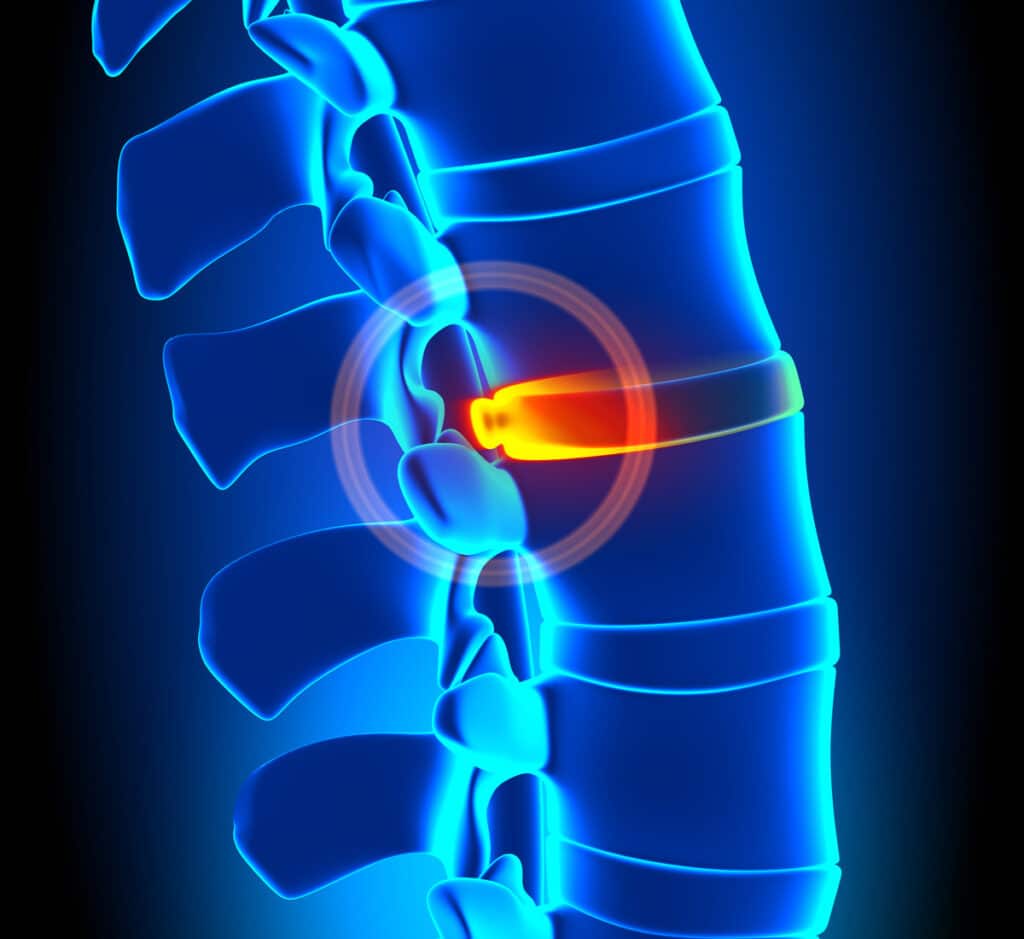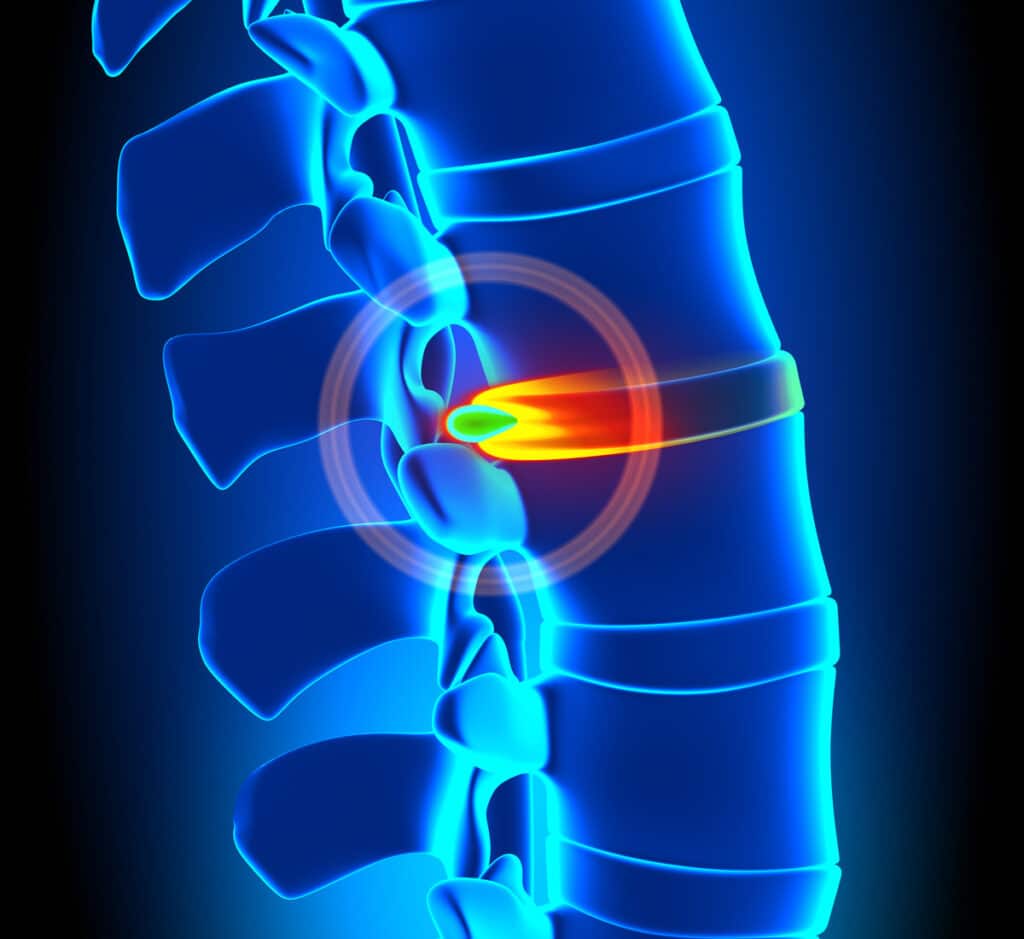You often hear them in the same sentence and used interchangeably, but bulging disc and herniated disc have several key differences that should be well understood by anyone at risk.
We will explore the key differences between bulging discs and herniated discs, two common spinal conditions that can cause discomfort and pain.
By understanding the definitions, causes, symptoms, diagnosis, and treatment options for each condition, readers will gain valuable knowledge about these spinal issues.
Whether you are a healthcare professional or an individual seeking information, this article aims to serve as a comprehensive resource to help you differentiate between bulging and herniated discs.
What are Bulging Discs?

Bulging discs, also known as disc protrusion, refer to a spinal medical condition where the intervertebral discs located between the vertebrae in the spine become displaced or distorted. These discs act as cushions and shock absorbers for the spinal canal, consisting of a soft gel-like center (nucleus pulposus) surrounded by a tough outer layer (annulus fibrosus).
In the case of bulging discs, the outer layer weakens or tears, causing the inner gel-like material to push against the weakened area and bulge outwards. This bulging can lead to compression or irritation of nearby spinal nerves, resulting in pain, numbness, tingling, or weakness in the affected area of the body. Bulging discs commonly occur due to age-related degeneration, repetitive strain, poor posture, or traumatic injury, and their severity can vary depending on the extent of disc displacement and nerve involvement.
Treatment options for bulging discs include rest, physical therapy, pain management, and in severe cases, surgical intervention.
And What Are Herniated Discs?

A herniated disc, also known as a slipped or ruptured disc, refers to a condition where the soft inner portion of a spinal disc protrudes through the tough outer layer. This condition typically occurs in the spine’s neck or lower back region, resulting in pain, numbness, tingling, or weakness in the affected area and potentially along the nerve pathways connected to it.
The Main Differences between Bulging Discs and Herniated Discs
When comparing herniated discs to bulging discs, which are often used interchangeably but have distinct differences, the key distinction lies in the severity of the spinal disc’s displacement.
While both conditions are a form of disc degeneration and involve the displacement of disc material, a herniated disc refers to a more severe condition where the inner core, or disc nucleus, ruptures and extrudes through the outer layer. This rupture can cause the disc material to press against nearby nerves, leading to pain and other symptoms.
On the other hand, a bulging disc occurs when the disc material extends beyond its normal boundaries, causing the disc to bulge outward. Unlike a herniated disc, a bulging disc typically does not involve a rupture or tearing of the outer layer. This condition may or may not cause symptoms, depending on whether the bulging disc puts pressure on nearby nerves or other structures.
To summarize: while both herniated, and bulging discs involve the displacement of disc material, a herniated disc involves a rupture and protrusion of the inner core, potentially causing more severe symptoms. A bulging disc, on the other hand, refers to an extension of disc material beyond its normal boundaries, which may or may not result in symptoms.
Treatment options for bulging and herniated discs include physical therapy, pain management techniques, medication, and in some cases, surgery. It is essential to consult with a medical professional for an accurate diagnosis and appropriate treatment plan.
Causes of Bulging and Herniated Discs
The causes of a bulging and a herniated disc can vary, although they share some similarities.
Both conditions can also be influenced by factors such as poor posture, obesity, lifting heavy objects, and repetitive movements that put strain on the spine. These factors can contribute to the weakening of the discs and make them more susceptible to bulging or herniating.
What Causes a Bulging?
Degeneration of the spinal discs is a common cause of both bulging and herniated discs. When the discs in the spine start to degenerate, they become weaker and less able to withstand pressure. This degeneration can be caused by aging, wear and tear, repetitive stress put on the spinal cord, or spinal injury. Even improper lifting techniques when at the gym can lead to severe herniation or bulging in the long term.
What Causes a Herniated Disc?
Disc herniation occurs when the soft inner core of a spinal disc, the disc material, pushes through the outer layer, leading to sharp pain and discomfort.
Similar to bulging, factors can contribute to the development of a herniated disc, including:
- Aging: As we age, the discs in our spine lose their flexibility and become more prone to injury.
- Trauma: Accidents or injuries that put excessive pressure on the spine can cause a disc to herniate.
- Poor posture: Maintaining improper posture over time can put stress on the discs and increase the risk of herniation.
- Repetitive activities: Engaging in repetitive motions, such as heavy lifting or twisting, can gradually weaken the outer layer, making it more susceptible to herniation.
It’s important to note that a disc herniates anywhere along the spinal canal, potentially affecting the spinal cord or spinal nerves.
Symptoms for Herniated and Bulging Disc

An important reason why it might be difficult to differentiate between the types of disc degeneration in the spinal canal is the overlapping symptoms. In most cases, studies and imaging are the only ways to precisely diagnose the cause of the pain and discomfort.
But that doesn’t mean there aren’t any differences between a bulging and herniated disc. Understanding the common symptoms associated with each condition can help individuals identify and seek appropriate treatment for their specific disc issue.
Common Symptoms of a Bulging Disc
One of the most prevalent symptoms experienced by individuals with a bulging disc is radiating pain that shoots down the leg, commonly known as sciatica. This pain occurs due to the compression or irritation of the nerves in the spine caused by the bulging.
In addition to leg pain, there are several other common symptoms associated with bulging :
Weakness
Individuals may experience weakness in the affected leg or foot, making it difficult to perform everyday activities.
Numbness or tingling
The compression of nerves can lead to numbness or tingling sensations in the leg or foot.
Loss of bladder or bowel control
In severe cases, a bulging disc can cause a loss of control over bladder or bowel function.
Limited range of motion
The pain and discomfort from a bulging disc can restrict the individual’s ability to move the affected area freely.
Common Symptoms of a Herniated Disc
In contrast, individuals with a herniated disc often experience a combination of localized pain, not radicular pain, along with numbness and weakness in the affected area. These common symptoms can vary depending on the location and severity of the herniation. A hernia in the neck most of the time will stay only as neck pain, with some radiation and weakness in the arms, for example.
Nonetheless, radiating severe pain can also be present in cases of disc herniation. Numbness and tingling sensations may also be present, indicating nerve compression. Weakness in the muscles served by the affected nerves is another common symptom.
It is important to note that these symptoms can be exacerbated by certain activities, such as bending, lifting, or coughing.
Diagnosis of Bulging and Herniated Discs
When it comes to diagnosing a bulging or herniated disc, there are a few key methods that a spine specialist will rely on, and it can include a simple physical examination, a medical history review, and some tests.
How is a Bulging or Herniated Disk Diagnosed?
The diagnosis of a bulging or herniated disc typically involves a combination of medical history, physical examination, and imaging tests. When it comes to diagnosing a bulging or herniated disc, healthcare professionals follow a systematic approach to ensure an accurate diagnosis and appropriate treatment plan.
Medical History
The healthcare provider will ask questions about your symptoms, including the location and severity of pain, any previous injuries or medical conditions, and any activities that worsen or alleviate your symptoms.
Physical Exam
The healthcare provider will perform a physical examination, which may involve testing your muscle strength, reflexes, and range of motion. They may also perform specific tests to assess the integrity of your core muscles.
Imaging Tests
To confirm the diagnosis, imaging tests such as X-rays, MRI scans, or CT scans may be ordered. These tests provide detailed images of the spine, allowing healthcare professionals to identify any signs of wear and tear, spinal stress, or bulging or herniated discs and assess the extent of the condition.
Treatments for Bulging and Herniated Discs

When it comes to treating both bulging and herniated discs, options include physical therapy, pain medication, surgery, and epidural steroid injections, although the options can vary between the two depending on the severity of the cases and should not be considered to be identical conditions when seeking treatment.
It is important to consult with a healthcare professional to determine the most suitable treatment plan for each individual case.
Treatment Options for a Bulging Disc
While there is no one-size-fits-all approach, various treatment options are available for managing a bulging. These treatment options aim to alleviate pain, promote healing, and prevent further damage. Here are some treatment options that can be considered:
Physical therapy
Engaging in specific exercises and stretches can help strengthen the muscles surrounding the affected area and improve flexibility, ultimately reducing pain and promoting healing.
Medications
Nonsteroidal anti-inflammatory drugs (NSAIDs), such as ibuprofen, can help with acute pain relief and reduce inflammation in the affected portion of the spine.
Hot and cold therapy
Applying heat or cold to the affected area can provide temporary relief from pain and reduce inflammation.
Lifestyle modifications
Making changes in daily activities, such as avoiding heavy lifting or using proper body mechanics when lifting objects, can prevent further strain on the spine and promote the healing process.
Treatment Options for a Herniated Disc
When it comes to treating a herniated disk, there are several options available that can help alleviate pain and promote healing.
Non-surgical treatments are often the first line of defense and may include rest, physical therapy, pain management techniques, and anti-inflammatory medications to reduce inflammation. Physical therapy exercises can help strengthen the surrounding muscles and improve flexibility, providing support to the spine.
In some cases, epidural steroid injections may be recommended to reduce inflammation and relieve pain.
Is Surgery Needed for Bulging or Herniated Disc?
If non-surgical treatments do not provide sufficient relief, surgical options such as discectomy or spinal fusion may be considered. These procedures aim to remove the herniated portion of the disk or stabilize the spine. This will help to alleviate the pressure on the affected nerves and bones.
The decision for a surgical solution should not be taken lightly and must be considered with the guidance of a board-certified orthopedic spine surgeon in Dana Point, CA like Dr. Hamid Mir with fellowship training in combined neuro and orthopedic spine surgery techniques, who is based in Orange County, CA. He has 18 years of experience in minimally invasive spine surgeries using advanced microscopic techniques.
With his expertise, compassionate approach, and medical team, you can trust Dr. Mir to guide you through the diagnosis, treatment, and recovery process, ensuring the best possible outcomes for your spinal health. Don’t wait; schedule your appointment today and take the first step towards a healthier spine.
By seeing a spine doctor like Dr. Hamid Mir immediately after diagnosis, you can access the best available treatment options and receive comprehensive care tailored to your specific needs, ultimately improving your quality of life and minimizing the impact of degenerative disc disease on your daily activities.
Remember that understanding the difference between bulging discs and herniated discs is crucial for accurate diagnosis and treatment.
While both conditions involve damage to the discs in the spine, a bulging disc occurs when the disc protrudes outward, whereas a herniated disc occurs when the annulus fibrosus ruptures or tears.
The causes, symptoms, and treatments vary for each condition, emphasizing the importance of proper diagnosis by a healthcare professional and spine surgeon in Dana Point, CA.



